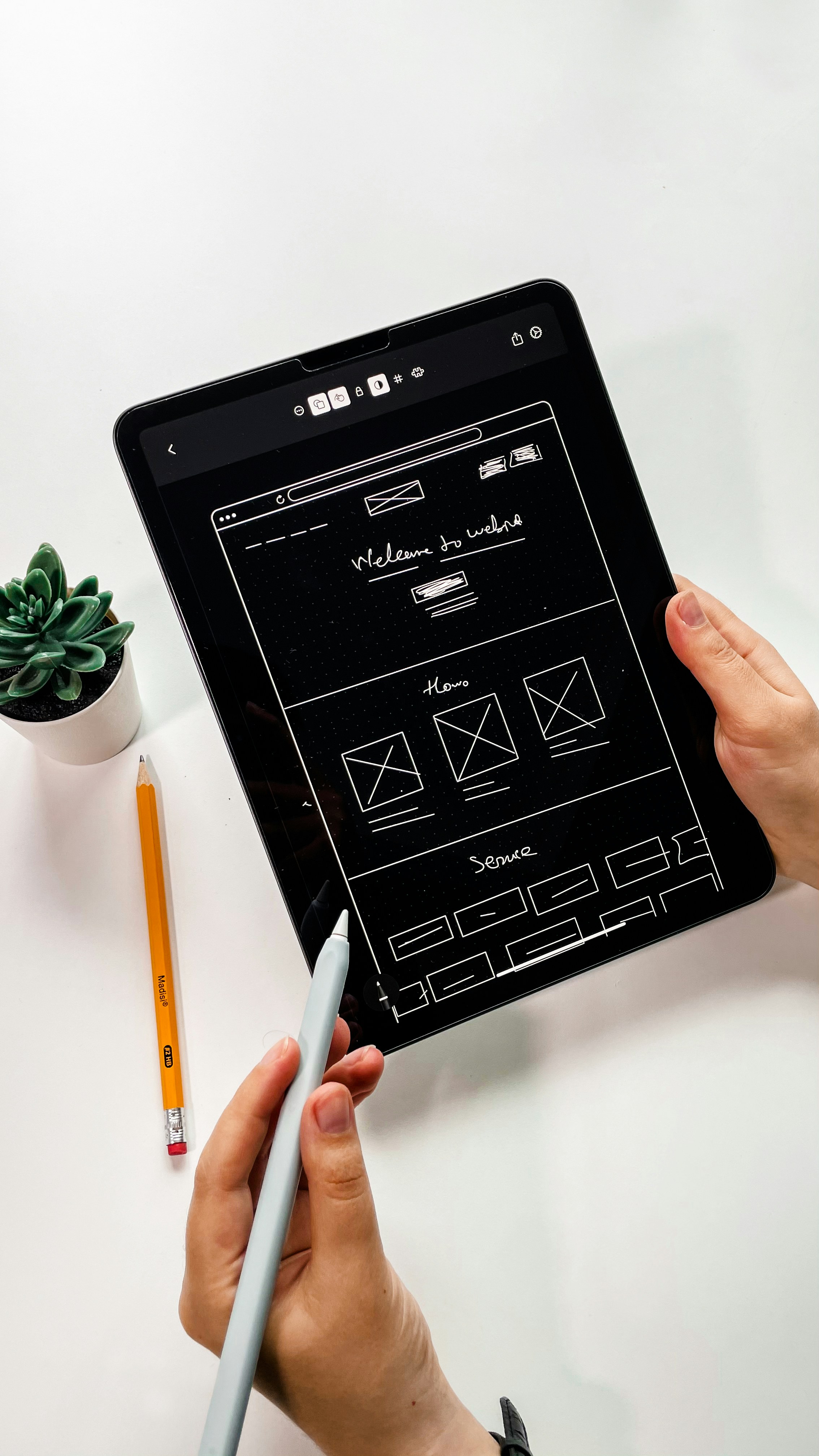Apr 2, 2024
There are several common web design mistakes that can negatively impact its performance. These mistakes can range from technical issues like slow loading speeds to user experience (UX) challenges such as unclear navigation and cluttered interfaces. Identifying and addressing these pitfalls is essential for optimizing a website's effectiveness and achieving desired outcomes. We’ll delve into the top 5 web design mistakes that businesses should be aware of and provide expert tips to help you avoid them.
Mistake #1: Ignoring Mobile Responsiveness
One of the most common and detrimental web design mistakes is ignoring the importance of mobile responsiveness. In today's digital landscape, where the majority of web traffic comes from mobile devices, having a website that is not optimized for mobile can severely hinder its performance and success. [1][2][4][5]
A website that is not mobile-friendly can lead to a poor user experience, with users struggling to navigate, read content, and interact with the site on their smaller screens. This high bounce rate and low engagement signals to search engines that the website is not providing a satisfactory experience for mobile users. As a result, the website's search engine rankings may plummet, leading to decreased organic traffic and potential loss of revenue. [1][2][4][5]
To ensure your website is mobile-friendly, Check out The Ultimate Guide to Responsive Web Design: Making Your Website Mobile-Friendly
Mistake #2: Overcomplicating Navigation
A. The Significance of Intuitive Navigation for User Engagement
Effective website navigation is a critical component of user experience. A well-designed navigation system allows users to easily find the information or actions they need, ultimately enhancing engagement and driving conversions. Conversely, overly complex or cluttered navigation can frustrate users, leading to high bounce rates and a negative perception of the website. [6][7][8][9]
B. Common Navigation Pitfalls to Avoid
Some of the most common navigation mistakes that can overcomplicate the user experience include:
1. Excessive menu options: Providing too many menu items can overwhelm users and make it difficult for them to quickly locate the desired content or functionality. [6][7][9]
2. Unclear or misleading navigation labels: Vague or confusing menu titles can cause users to get lost or fail to find what they're looking for. [6][8]
3. Lack of visual hierarchy and organization: Failing to clearly separate and distinguish between main categories and subcategories can make the navigation structure unclear. [6][8]
4. Burying important features: Hiding critical actions or information deep within the navigation can frustrate users and prevent them from easily accessing what they need. [6][8][9]
C. Expert Tips for Simplifying Navigation Structures
To create an intuitive and user-friendly navigation experience, experts recommend the following:
1. Limit the number of menu items: Aim for no more than 7-8 top-level navigation options to avoid overwhelming users. [6][7][9]
2. Use clear, descriptive labels: Ensure that navigation titles and links accurately reflect the content or functionality they lead to. [6][8]
3. Organize navigation logically: Group related items together and clearly distinguish between main categories and subcategories using visual cues like color, spacing, or icons. [6][8]
4. Prioritize important features: Ensure that critical actions or information are easily accessible, either through prominent placement in the main navigation or via secondary navigation elements. [6][8][9]
5. Continuously test and iterate: Gather user feedback and analyze navigation behavior to identify areas for improvement and optimize the user experience over time. [6][8]
Mistake #3: Neglecting Page Speed Optimization
One of the most critical web design mistakes is neglecting page speed optimization. Page load speed is a crucial factor that directly impacts both user experience and search engine optimization (SEO). [10][11][12][13]
From a user experience perspective, slow-loading websites can lead to high bounce rates, decreased engagement, and ultimately, lost conversions. Users expect websites to load quickly, and even a slight delay can cause them to abandon the site and seek alternatives. [10][11][12]
In terms of SEO, page speed is a direct ranking factor used by search engines like Google. Websites with faster loading times are more likely to rank higher in search results, leading to increased visibility and organic traffic. Slow-loading sites, on the other hand, can be penalized by search engines, negatively impacting their search engine rankings. [10][11][13]
Several factors can contribute to slow page load speeds, including:
1. Unoptimized media files (images, videos, and other large assets) [10][11][12]
2. Excessive use of heavy scripts and plugins[10][11][12]
3. Poorly structured or bloated HTML, CSS, and JavaScript code[10][12]
4. Lack of server-side caching and optimization[10][12]
5. Hosting on an inadequate or overloaded server[10][11][12]
To address the issue of slow page load speeds, experts recommend the following strategies:
1. Optimize media files: Compress and resize images, videos, and other large assets to reduce their file size without compromising quality. [10][11][12]
2. Minimize the use of heavy scripts and plugins: Carefully evaluate the necessity of each script and plugin, and remove or optimize any unnecessary ones. [10][11][12]
3. Minify and optimize HTML, CSS, and JavaScript: Remove unnecessary whitespace, comments, and other redundant code to reduce file sizes. [10][12]
4. Implement server-side caching: Utilize caching mechanisms, such as browser caching and content delivery networks (CDNs), to reduce the number of server requests and improve response times. [10][12]
5. Upgrade hosting and server infrastructure: Ensure your website is hosted on a reliable and high-performance server that can handle the traffic and resource demands of your site. [10][11][12]
Mistake #4: Poor Content Organization and Readability
Effective content organization and readability are crucial for engaging users and delivering a positive experience. When content is well-structured and easy to read, it helps users quickly find the information they need, understand the key points, and stay engaged throughout the entire piece. [14][15][16][17][18]
On the other hand, poorly organized content with low readability can frustrate users, leading to high bounce rates, decreased time on page, and ultimately, lost conversions. Users are more likely to skim or abandon content that is difficult to navigate or comprehend. [14][15][16][17][18]
Some of the most common content organization and readability mistakes include:
1. Lengthy, dense paragraphs with complex sentence structures [14][16][18]
2. Lack of clear headings and subheadings to guide the reader [14][15][17]
3. Inconsistent formatting and hierarchy throughout the content [14][15][17]
4. Excessive use of jargon, industry-specific terminology, and complex language [14][16][18]
5. Cluttered layouts with insufficient white space and visual breaks [14][16][18]
To enhance content readability and organization, experts recommend the following strategies:
1. Break up content into short, concise paragraphs that convey a single idea or message. [14][16][18]
2. Use clear, descriptive headings and subheadings to guide the reader and provide visual cues. [14][15][17]
3. Maintain a consistent formatting hierarchy, using bold, italics, or different font sizes to distinguish levels of importance. [14][15][17]
4. Avoid jargon and industry-specific terminology, opting for plain, conversational language. [14][16][18]
5. Incorporate visual elements, such as images, graphs, or bullet points, to break up the text and make the content more scannable. [14][16][18]
6. Ensure ample white space and line breaks to create a clean, uncluttered layout. [14][16][18]
7. Test your content by reading it aloud to identify areas that may be difficult to understand or follow. [14][18]
Mistake #5: Lack of Clear Call-to-Action (CTA)
One of the most critical web design mistakes is the lack of clear and compelling Call-to-Action (CTA) elements. CTAs play a vital role in guiding user behavior and driving conversions on a website. [19][20][21][22][23]
Effective CTAs provide users with a clear and actionable next step, whether it's signing up for a newsletter, making a purchase, or downloading a resource. By strategically placing CTAs throughout the user journey, you can nudge users towards the desired conversion actions, ultimately contributing to the overall success of your website. [19][20][21][22][23]
Some common examples of weak or missing CTAs include:
1. Vague or unclear CTA copy, such as "Click here" or "Submit" [19][21][22]
2. Lack of visual hierarchy and prominence for the CTA button [19][21][23]
3. Placement of CTAs in inconspicuous or hard-to-find locations [19][20][23]
4. Absence of CTAs altogether, leaving users unsure of the next step [19][20][23]
5. Misalignment between the CTA and the content or user intent [19][21][22]
To create compelling and effective CTAs, experts recommend the following strategies:
1. Use clear, action-oriented language: Craft CTA copy that is concise, straightforward, and tells the user exactly what to do. [19][20][21][22]
2. Optimize the visual design: Make the CTA button visually prominent, using contrasting colors, appropriate sizing, and strategic placement. [19][21][23]
3. Align CTAs with user intent and context: Ensure the CTA is relevant and aligned with the user's current needs and the content on the page. [19][21][22]
4. Leverage social proof and urgency: Incorporate elements like testimonials, scarcity, or limited-time offers to create a sense of urgency and increase conversion rates. [19][21]
5. Continuously test and iterate: Conduct A/B testing to identify the most effective CTA variations and continuously optimize based on user behavior and performance data. [19][20]
_____________________________________________________________________________
Citations:
[1] https://fastercapital.com/topics/common-mobile-optimization-mistakes.html
[2] https://www.promaticsindia.com/blog/9-responsive-design-mistakes-you-dont-want-to-make
[3] https://cubettech.com/resources/blog/10-mobile-responsive-mistakes-that-will-change-your-perspective-on-responsiveness/
[4] https://www.lambdatest.com/blog/top-mistakes-to-avoid-during-responsive-web-design/
[5] https://www.linkedin.com/advice/0/what-most-common-mistakes-when-designing-responsive-cgr7f
[6] https://www.netguru.com/blog/ux-tips-to-improve-website-navigation
[7] https://www.linkedin.com/advice/0/what-most-common-mistakes-when-designing-navigation-sxq5f
[8] https://usabilitygeek.com/app-navigation-design-mistakes/
[9] https://neilpatel.com/blog/common-website-navigation-mistakes/
[10] https://yoast.com/how-site-speed-influences-seo/
[11] https://www.linkedin.com/pulse/impact-page-speed-seo-user-experience-dhiman-mondal
[12] https://www.linkedin.com/pulse/how-optimize-website-speed-enhance-user-experience-1702-digital
[13] https://searchengineland.com/speed-page-experience-seo-387478
[14] https://searchengineland.com/content-readability-426971
[15] https://www.linkedin.com/advice/1/how-can-you-structure-your-web-content-maximum
[16] https://websitevoice.com/blog/content-readability/
[17] https://neilpatel.com/blog/common-website-navigation-mistakes/
[18] https://carminemastropierro.com/how-to-improve-content-readability/
[19] https://mention.com/en/blog/call-to-action-marketing-strategy/
[20] https://blog.beehiiv.com/p/email-call-to-action
[21] https://yeswebdesignstudio.com/blog/psychology-behind-call-to-action/
[22] https://www.linkedin.com/pulse/creating-compelling-calls-action-driving-conversions-d3x9c
[23] https://digitalmarketerbee.com/the-importance-of-ctas-in-website-conversions/

Why Website Accessibility Guidelines Are Important in 2024
Jul 10, 2024

How Much Does a Website Cost?
May 23, 2024

Top 10 Web Design Failures of All Time and What We Can Learn from Them
Apr 30, 2024

Top 5 Mistakes to Avoid in Web Design
Apr 2, 2024

Boosting Conversion Rates: How Website Design Impacts User Engagement
Apr 1, 2024

The Ultimate Guide to Responsive Web Design: Making Your Website Mobile-Friendly
Mar 28, 2024

Top 15 Questions to Ask Web Designers Before Hiring Them
Mar 27, 2024

Building Small Business Websites
Mar 26, 2024

Looking for a premium local New York web designer for your premiere website?
Mar 25, 2024

How to choose a website designer
Apr 8, 2022

The Critical Role of SEO-Optimized Web Design
Mar 15, 2022

Why Strong Branding Makes You Stand Out From Your Competitors
Feb 28, 2022

What Is A User-Friendly Website And Why Should I Have One?
Feb 6, 2022

Why Local Businesses Should Use Long-Tail Keywords For SEO and Ads
Jan 12, 2022
